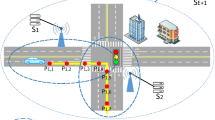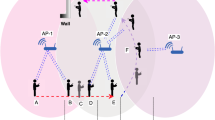Abstract
Combinatorial Mobile IP, a new mobility management scheme for Mobile IP, is proposed and analyzed. We present how to adopt mobility management schemes on cellular networks and adapt them in Mobile IP without disrupting the nature of the Internet. We apply widely used mobility management schemes such as hierarchical architecture and paging in cellular networks to Mobile IP. We restrict paging to the area that has to be paged using local registrations. In this way, we show that the total signaling costs of Combinatorial Mobile IP are reduced compared to other micro-mobility protocols such as Mobile IP Regional Registration and P-MIP. Random walk on a connected graph is used to analyze the performance of Combinatorial Mobile IP.
Similar content being viewed by others
References
A. Campbell, J. Gomez, C.-Y. Wan, S. Kim, Z. Turanyi and A. Valko, Cellular IP, Internet Draft (2000), work in progress, draft-ietfmobileip-cellularip-00.txt
A.T. Campbell and J. Gomez-Castellanos, IP micro-mobility protocols, ACM SIGMOBILE Mobile Computing and Communications Review (MC2R) 4(4) (2000) 45–53.
S.K. Das and S.K. Sen, A new location update strategy for cellular networks and its implementation using a genetic algorithm, in: Proceedings of the 3rd Annual ACM/IEEE International Conference on Mobile Computing and Networking (MOBICOM), Budapest, Hungary (1997) pp. 185–194.
A. Gamst, Application of graph theoretical methods to GSM radio network planning, in: Proceedings of IEEE International Symposium on Circuits and Systems (June 1991) pp. 942–945.
E. Gustafsson, A. Jonsson and C. Perkins, Mobile IPv4 regional registration, Internet Draft (2001), work in progress, draft-ietfmobileip-reg-tunnel-05.txt
H. Haverinet and J. Malinen, Mobile IP regional paging, Internet Draft (2000), work in progress, draft-haverinen-mobileip-regpaging-00.txt
G. Kirby, Locating the user, Communication International (October 1995).
L. Kleinrock, Queueing Systems: Theory, Vol. 1 (Wiley, 1975).
R. Motwani and P. Raghavan, Randomized Algorithms (Cambridge University Press, 1995).
C. Perkins, IP mobility support, Internet RFC 2002 (1996).
R. Ramjee, T.L. Porta, S. Thuel, K. Varadhan and S.Y Wang, HAWAII: A domain-based approach for supporting mobility in wide-area wireless networks, in: Proceedings of IEEE International Conference on Network Protocols (ICNP’99), Toronto, Canada (1999) pp. 283–292.
S. Ross, Stochastic Process (Wiley, 1983).
S.K. Sen, A. Bhattacharya and S.K. Das, A selective location update strategy for PCS users, ACM/Baltzer Wireless Networks 5(5) (1999) 313–326.
S. Subramanian and S. Madhavapeddy, System partitioning in a cellular network, in: Proceedings of 46th IEEE Vehicular Technology Conference, Atlanta, CA (1996) pp. 106–110.
X. Zhang, J. Castellanos, A. Campbell, K. Sawada and M. Barry, P-MIP: Minimal paging extensions for mobile IP, Internet Draft (2000), work in progress, draft-zhang-pmip-00.txt
Author information
Authors and Affiliations
Rights and permissions
About this article
Cite this article
Choi, T., Kim, L., Nah, J. et al. Combinatorial Mobile IP: A New Efficient Mobility Management Using Minimized Paging and Local Registration in Mobile IP Environments. Wireless Networks 10, 311–321 (2004). https://doi.org/10.1023/B:WINE.0000023864.73253.b7
Issue Date:
DOI: https://doi.org/10.1023/B:WINE.0000023864.73253.b7




